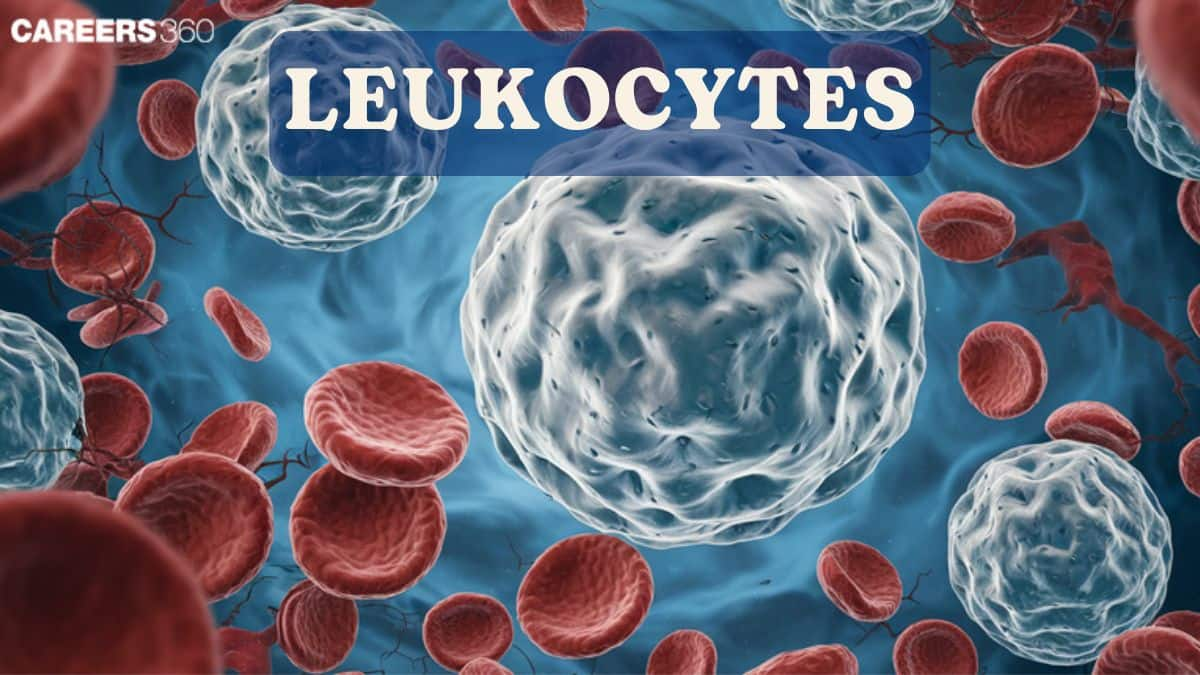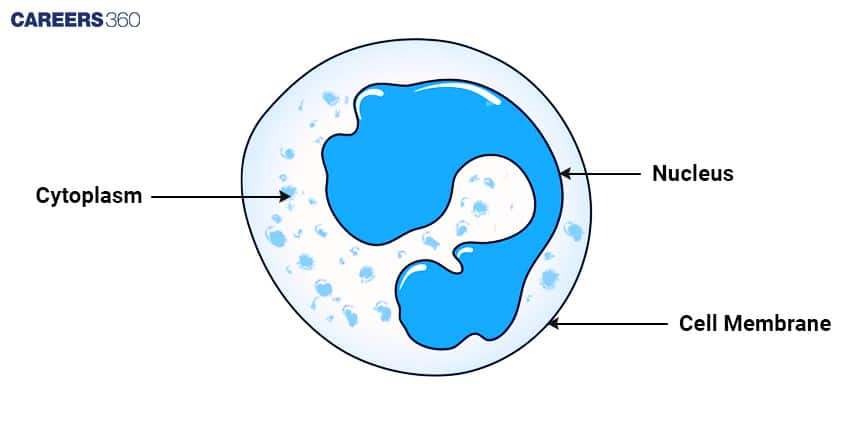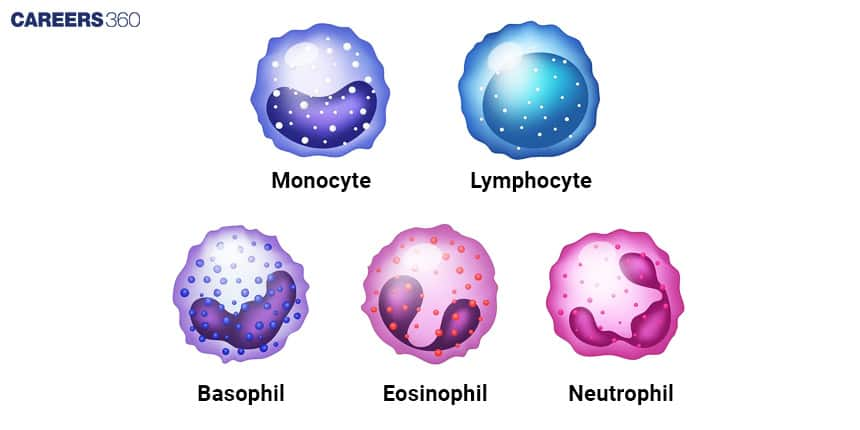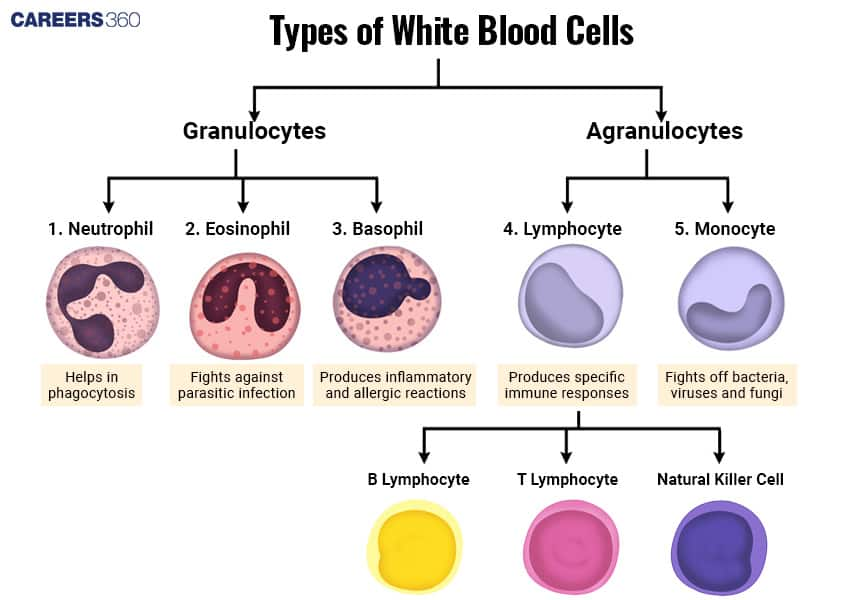Leukocytes
Leukocytes, or white blood cells (WBCs), are key immune cells that defend the body against pathogens. They include granulocytes and agranulocytes, each with specialized roles in immunity, inflammation, and disease protection. Disorders of leukocytes, such as leukemia and leukopenia, highlight their medical significance.
This Story also Contains
- What Are Leukocytes?
- Structure of Leukocytes
- Types of Leukocytes
- Functions of Leukocytes
- Specific Roles of Different Leukocytes
- Production & Lifespan of Leukocytes
- Disorders Of Leukocytes
- Clinical relevance of WBC count
- Leukocytes NEET MCQs (With Answers & Explanations)
- Recommended video on Leukocytes

What Are Leukocytes?
Leukocytes are more popularly known as white blood cells (WBCs). The two principal types are granulocytes and agranulocytes. They form an integral part of the immune system and play a very important role in body defence against infections, foreign invasions, and diseases.
In contrast to erythrocytes, leukocytes are not restricted to the blood. They move in and out of blood vessels into the tissues to perform their functions wherever necessary. Except for lymphocytes, which may live for years, WBCs usually live for only a few hours or a few days. Normal blood contains 5000–10,000 WBCs/μL.
Structure of Leukocytes
Unlike RBCs, WBCs have nuclei and a full complement of other organelles but they do not contain hemoglobin. The structure of WBCs consists of:
Nucleus: Unlike erythrocytes, the leukocyte does have a nucleus. It is considered an essential component because, without a nucleus, the leukocytes would not have the ability to function and reproduce.
Cytoplasm: The cytoplasm has many granules that assist in performing their immune functions.
Cell Membrane: The cell membrane is semipermeable and pliable. This allows the leukocyte to change shape and move through tissue.

Types of Leukocytes
WBCs are classified as either granular or agranular, depending on whether they contain cytoplasmic granules (vesicles) that are made visible by staining when viewed through a light microscope.
Granulocytes
After staining, each of the three types of granular leukocytes displays conspicuous granules with distinctive coloration that can be recognized under a light microscope. Granular leukocytes can be distinguished as follows:
Neutrophil: The granules of a neutrophil are smaller, evenly distributed, and pale lilac. Because the granules do not strongly attract either the acidic (red) or basic (blue) stain, these WBCs are neutrophilic. The nucleus has two to five lobes, connected by very thin strands of nuclear material.
Eosinophil: The large, uniform-sized granules within an eosinophil are eosinophilic—they stain red orange with acidic dyes. The granules usually do not cover or obscure the nucleus, which most often has two lobes connected by a strand.
Basophil: The round, variable-sized granules of a basophil are basophilic—they stain blue-purple with basic dyes. The granules commonly obscure the nucleus, which has two lobes.
Agranulocytes
Even though agranular leukocytes possess cytoplasmic granules, the granules are not visible under a light microscope because of their small size.
Lymphocyte: The nucleus of a lymphocyte stains dark and is almost round. The cytoplasm stains blue. The larger the cell, the more cytoplasm is visible.
Monocyte: The nucleus of a monocyte is kidney- shaped, and the cytoplasm is blue-gray. These migrate from the blood into the tissues, where they enlarge and differentiate into macrophages.

Functions of Leukocytes
Each type of white blood cell plays a different role: determining the percentage of each type in the blood assists in diagnosing the condition.
Defence Against Infections: Leukocytes recognize the disease-causing organisms like bacteria, viruses, and fungi, and destroy them.
Immune Response Regulators: They act as immune response regulators by displaying signals that communicate with other immune cells and instruct them in their actions.
Inflammation: The inflammatory response in which leukocytes take part helps to isolate and clear the pathogenic agents.
Specific Roles of Different Leukocytes
The role of different types of leukocytes are:
Role of Neutrophils
Neutrophils are the most common granulocytes and can often be the first to arrive at the site of infection.
They internalize and digest pathogens through the process of phagocytosis.
Their rapid response and capacity for creating reactive oxygen species make them critical during the early natural phase of immune defence.
Role of Lymphocytes
Lymphocytes play a central role in adaptive immunity. There are two major types:
B Lymphocytes: These cells produce antibody proteins that recognize specific pathogens.
T Lymphocytes: These cells can, in a process called apoptosis, directly kill infected cells, or they help to control the immune response.
Role of Monocytes
Monocytes are large WBCs that mature into macrophages and dendritic cells when they enter tissues.
As mentioned earlier, macrophages phagocytize and present antigens to T lymphocytes.
Dendritic cells also present antigens to T lymphocytes.
Furthermore, dendritic cells activate the adaptive immune response.

Production & Lifespan of Leukocytes
Lifespan: Although some lymphocytes have a lifetime measured in years, most formed elements of the blood last only hours, days, or weeks, and must be replaced continually. The abundance of the different types of WBCs, however, varies in response to invading pathogens and other foreign antigens.
Hematopoiesis: The process by which the formed elements of blood develop is called hemopoiesis or hematopoiesis. Stem cells in red bone marrow proliferate and differentiate into cells that give rise to blood cells. In order to form blood cells, pluripotent stem cells in red bone marrow produce two further types of stem cells, which develop into several types of cells. These stem cells are called myeloid stem cells and lymphoid stem cells. Myeloid stem gives rise to red blood cells, platelets, monocytes, neutrophils, eosinophils, basophils, and mast cells. Lymphoid stem cells, which give rise to lymphocytes.
Disorders Of Leukocytes
Determining the percentage of leukocytes in the blood assists in diagnosing the condition.
Leukaemia: It is a kind of cancer that is marked by the uncontrolled multiplication of abnormal leukocytes.
Leukocytosis: Leukocytosis , an increase in the number of WBCs above 10,000/μL, is a normal, protective response to stresses such as invading microbes, strenuous exercise, anesthesia, and surgery.
Leukopenia: An abnormally low level of white blood cells (below 5000/μL) is termed leukopenia. It is never beneficial and may be caused by radiation, shock, and certain chemotherapeutic agents. A low count of white blood cells increases the susceptibility to infections.
Lymphoma: A cancer of the lymphatic system that affects lymphocytes.
Clinical relevance of WBC count
Leukocytes are essential in maintaining good health. The skin and mucous membranes are continuously exposed to microbes. Some of these microbes can invade to cause disease. Once pathogens enter the body, the general function of white blood cells is to combat them by phagocytosis or immune responses.
To accomplish these tasks, many WBCs leave the bloodstream and collect at sites of pathogen invasion or inflammation. The cells help in fighting infections and diseases. Because of their ability to amend their shape and phagocytose most pathogens, they become part of the immune system. WBC count may, in turn, be observed to give a related fact about one's health status.
Leukocytes NEET MCQs (With Answers & Explanations)
Important topics for NEET are:
Types of leukocytes (agranulocytes and granulocytes)
Specific role of different leukocytes
Practice Questions for NEET
Q1. The life span of WBCs in humans is
100 days
50 days
7 days
13-20 days
Correct answer: 4) 13-20 days
Explanation:
White blood cells (WBCs) are essential components of the immune system, responsible for defending the body against infections and foreign substances. They can be classified into two main categories: granulocytes, which contain granules in their cytoplasm (such as neutrophils, eosinophils, and basophils), and agranulocytes, which lack visible granules (such as lymphocytes and monocytes). WBCs are produced in the bone marrow and are found in the blood and lymphatic system. They play a crucial role in immune responses, including phagocytosis, antibody production, and the release of signaling molecules like cytokines.
Hence, the correct answer is option 4 - 13-20 days
Q2. The blood corpuscles which lack hemoglobin and are involved in defense against infections are called
Erythrocytes
Thrombocytes
Platelets
Leukocytes
Correct answer: 4) Leukocytes
Explanation:
Leukocytes, or white blood cells, are a crucial component of the immune system and are found in the blood. Unlike red blood cells, they lack hemoglobin and do not carry oxygen. Their primary function is to defend the body against foreign invaders, such as bacteria, viruses, and other pathogens that cause infections and diseases. Leukocytes are capable of recognizing and responding to these threats through various immune mechanisms, including phagocytosis, antibody production, and the activation of other immune cells, thereby playing a vital role in maintaining the body's health and fighting infections.
Hence, the correct answer is option 4) Leukocytes.
Q3. Level of WBCs increases during
Acute infection
Appendicitis
Leukemia
All of these
Correct answer: 4) All of these
Explanation:
Leukocytosis is usually observed during an acute infection like pneumonia, an inflammatory condition like appendicitis, and in malignancies like leukaemia. White blood cell counts are elevated during infections or inflammation, which represents the body's attempt to counteract the invader. Most of the responses involve neutrophils, while increases in lymphocytes may occur because of viral infections. Thus, monitoring the count of leukocytes is very essential for the diagnosis and management of several medical conditions.
Hence, the correct answer is Option 4) All of these.
Also Read:
Recommended video on Leukocytes
Frequently Asked Questions (FAQs)
The major types of leukocytes include granulocytes and agranulocytes.
Leukocytes are produced in the bone marrow via a process called hematopoiesis.
Neutrophils constitute the first line of defence against pathogens. They phagocytose and digest them.
Leukemia is a type of cancer that is characterized by the excessive production of abnormal leukocytes.
The cells of the immune system that constitute the white blood cells fighting against infection and disease in the body are called leukocytes.